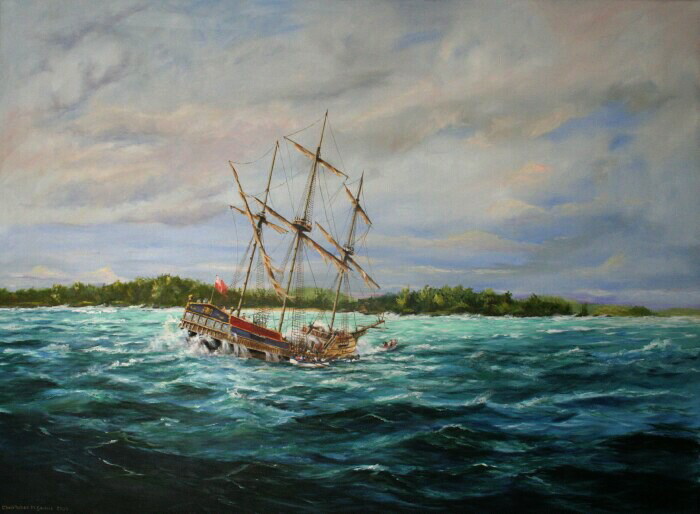William Strachey’s account of the battle the Sea Venture waged against the storm that ultimately led to her wreckage is a terrifying read.
It was 1609. There was no GPS, no coast guard and no way to track the winds. Hundreds of miles off course, the 300-ton flagship of the London Company was battered for three days and four nights after cruising into the “dangerous quarter of the storm, at about 33 degrees north latitude”.
In command of the journey from Plymouth, England to Jamestown, Virginia were some of Britain’s finest seamen: among them Admiral Sir George Somers, a war hero dubbed “lion at sea”; Captain Christopher Newport, an experienced New World sailor on his fourth journey to Jamestown; and Sir Thomas Gates, appointed to be the governor of the Jamestown colony by King James.
The Atlantic storm that hit them on July 24 was a new danger for them all.
“A hell of darkness turned black upon us,” is how Strachey, an English writer whose works are among the primary sources for the early history of the English colonisation of North America, laid out the ordeal in a letter which is believed to have inspired William Shakespeare’s The Tempest.
The Chesapeake Research Consortium, a US nonprofit, drew on the letter for its 2005 retelling where it describes how Captain Newport “ran before the gale” hoping to save the ship. The move left them “trapped in the strongest winds swirling about the eye and spiralling towards the centre”.
The monster storm overwhelmed them completely. Waves “as high as mountains” broke over the ship, “swelling and roaring as if in fits, covering the ship from stern to stem, like a garment”. Lightning crackled and the ghostly lights of St Elmo’s fire leapt between the masts.
“Six and sometimes eight men were not enough to hold the whipstaff in the steerage, or the tiller below in the gunner room: by which may be imagined the strength of the storm, in which the sea swelled above the clouds and gave battle unto heaven,” Strachey wrote.
“The violent wrenching literally worked the caulking out of Sea Venture’s seams; the crew was sent creeping below decks with candles to look for leaks and staunch them with anything at hand.”
According to Strachey, although a massive leak in the gunner’s room was stuffed with “I know not how many pieces of beef”, it wasn’t enough; the waters kept rising, presumably because of holes that couldn’t be found.
All of the ship’s 30 seamen and its 120 passengers — many of whom had never been to sea —got to work bailing.
“The water was five feet deep above the ship’s ballast. A huge rogue wave — an unpredictable and abnormally large surface wave — completely buried the ship from her forecastle over the entire waist or central decks. The crew thought the ship was so long submerged that she would simply sink, but slowly Sea Venture laboured up again, still floating.”
Sparks at the rigging added to the terror of the wind, the dark, the huge waves and the rain.
“For four-and-twenty hours the storm in a restless tumult had blown so exceedingly as we could not apprehend in our imaginations any possibility of greater violence…the waters like whole rivers did flood the air…winds and seas were as mad as fury and rage could make them.”
According to Strachey, even though they were removing about 100 tons of water six times a day, the water in the ship’s hull remained ten feet deep.
“Every hour, the passengers bucketed 7,200 to 8,000 gallons of water overboard and they had three deep pumps in continual operation pumping 4,000 strokes at each four-hour watch.”
By July 28, the fourth morning, everyone was close to exhaustion and agreed to simply “shut up the hatches” come nightfall and “commend their sinful souls to God”, having “committed the ship to the mercy of the gale”.
“Prayers might well be in the heart and lips,” Strachey wrote, “but [they were] drowned in the outcries.”
Around midday, they noticed that the water level had “growne five feet deepe above the ballast”, Strachey said. Men were floating rather than walking, it was obvious to everyone that the Sea Venture was going down.
At the exact moment “when no man dreamed of such happiness” Admiral Somers spotted land.
It was so close that he could see the trees swaying.
“But the seafloor, rising quickly beneath them, threatened to split the ship before they could reach shore. Calling on every skill, Somers steered hard, veering between two outcropping rocks. The ship wedged fast and splintered. Sea Venture was destroyed,” wrote Nick D’Alto on Historynet’s The Hurricane that Saved Jamestown.
“It must have seemed like a miracle. Braving the breakers in longboats, everyone was able to make it to shore. Passenger John Rolfe’s wife, ‘who was with childe’, was probably carried into the boat. A resourceful mate even rescued the admiral’s dog. Despite the potentially murderous storm, there had been no fatalities among roughly 150 aboard.”
This miraculous escape, with the ship succumbing close to a tiny area of land in the middle of the vast North Atlantic, proved the start of Bermuda’s history as an inhabited island. And perhaps no story better sums up Bermuda’s motto, “Quo fata ferunt” — whither the fates carry us.

